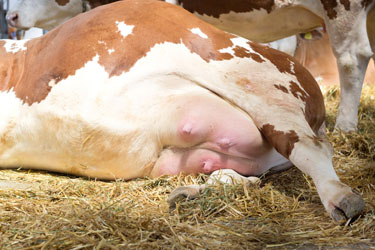Veterinarian Tips: Mastitis Prevention and Treatment

The most costly dairy industry disease, mastitis, creates problems that affect the animal, finances, and food safety. When evaluating the expenses associated with mastitis, dairy clients need to keep in mind that the financial loss associated with treating the disease extends beyond the cost of prevention.
Below is information you can give to your dairy clients to help:
Calculating the Costs of Mastitis
Running a dairy is a business. When balancing the cost of prevention versus the cost of treatment, the final decision has to be economically valid. When a cow is diagnosed with mastitis, her treatment involves way more than just an antibiotic.
The expected expenses surrounding a cow diagnosed with mastitis may come from veterinary service and the cost of medicine.
Other associated costs include:
- Increased risk of repeated cases of mastitis
- Greater susceptibility to developing other health issues that are related to mastitis, including:
- Lameness
- Ketosis
- Impaired fertility
- Calves born in a weakened state
- Discarded milk
- Cost of feed provided during the infection and treatment interval
- Reduced milk yield, which can be calculated for the rest of its lactation period or maybe the rest of its life
- Damage caused to the structure of the udder
- Decreased quality of milk
- Loss of value if cow has to be culled.
Prevention of Mastitis
Studies focused on prevention recommend implementing the following 7 basic procedures into the client’s herd management program. Applying these procedures doesn’t require much more than some attention and a little time.
#1. Maintain Living Conditions
It is important to keep the living area of the animals dry and comfortable. Stalls and lounging areas need to be regularly maintained and provided with clean and dry bedding as cows with dirty udders are more susceptible to developing mastitis
Signs of problems may be indicated by:
- Animals that choose not to rest in stalls or in the lounging area
- Animals that are dirty, especially on the areas that rest upon the bedding such as the udder, under the stomach, and on their rear quarters
#2. Proper Milking Procedures
In addition to cleanliness, dairy cattle need to be milked in a stress-free environment. Anxious or excited animals will not be able to relax and may not let all of their milk down. Calm music in the background, a quiet environment without shouting, and patience for handling the animals as they move in and out of the milking facility is necessary.
The following procedures for milking out cows should be adhered to:
- Check for mastitis every milking using a strip cup or mastitis strip
- Using a sanitizing solution, wash and clean the udder and teats
- Dry the teats and udder completely
- Massage the udder to start the let-down of milk and place milking unit on within 1 to 1 ½ minutes
- Listen for proper alignment of teat cups, because any noise indicates the unit needs adjustment
- Never remove the units without shutting off the vacuum first
- Close the teat openings immediately after removing the unit with either a dipping solution or a spray
#3. Milking Equipment Maintenance
Cattle are sensitive to stray electrical currents and improperly working equipment. Establishing a routine for periodic maintenance will help to identify any problems that could cause equipment failures and/or damage to the animals.
#4. Follow-up Teat Dip
Feeding the cattle after they are milked will keep them standing and allow the teat sphincter to fully contract and close the opening off to bacteria that could cause mastitis. To avoid freezing the teat ends, which could lead to mastitis, when the temperature drops below 10 degrees Fahrenheit, it’s also recommended to blot off any final drops of teat dip 30 seconds after the teat has been dipped and before turning the cows out of the milking facility.
#5. Apply a Drying-Off Treatment
Whenever a cow reaches the drying-off stage, administer a dry cow treatment to all four quarters.
#6. Treat Clinical Cases by Following Veterinarian Recommendations
The start of mastitis can be identified early by the daily use of a strip cup. However, when mastitis is repeatedly detected in an animal, the veterinarian should be contacted to determine the cause and to develop a treatment plan.
#7. Cull
Culling an animal is difficult but, at times, necessary. The following situations identify criteria for culling an animal from the herd:
- Cows that don’t respond to treatment
- Animals that are repeatedly infected as they could be considered carriers and spreaders of the disease
- Cows with udder damage, such as ones with lost quarters.
Taking the time to follow a prevention program is essential to preventing mastitis. By following these steps, financial losses from mastitis can also be prevented!
Here’s some additional information to pass on to your clients who have dairy cattle—Dairy Cattle Udder Hygiene. For you, the veterinarian, Covetrus offers information on bovine mastitis, as well as this free white paper, Obstacles and Opportunities Facing Livestock Veterinarians.
Contact your Covetrus representative for additional information to help clients with dairy herds online or at 855.724.3461.
Sources:
https://dairyquality.com/what-are-the-hidden-costs-of-mastitis/
http://digitalcommons.usu.edu/cgi/viewcontent.cgi?article=1454&context=extension_curall
Need Regulatory Assistance
If you need help with regulatory or licensing issues, we're happy to help. We have a wide variety of resources to help you when issues arise.

Careers
Are you looking for a place to let your talents shine? At Covetrus, we help our practitioner customers better serve their patients and take pride in providing the best customer experience possible. Search our open positions to see our available opportunities.
Newsletter
Stay current with what’s going on with Covetrus, subscribe to receive our newsletter and email communications. Subscribers will receive the latest information in practice management, sales and marketing, animal health, and more.


Leave a comment